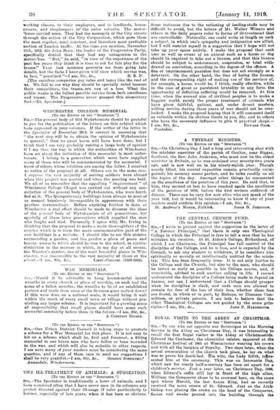ROYAL VISITS TO THE ABBEY AT CHRISTMAS. ITo THE Enrioa
or um "SPECTS701."1 one who sat opposite our Sovereigns at the Morning Service in the Abbey on Christmas Day, it was interesting to recall the first Royal visitor to the Abbey at Christmaatide. Edward the Confessor, the chronicler relates, appeared at the Christmas festival of 1063 at Weetminater wearing his crown and with all the insignia of Royalty. Two days later, when the actual conseeration of the church took place, he lay on what was to prove his death-bed. is wife, the Lady Edith, rebre- sented him at the ceremony. This was on Innocents Day, which now for nearly half-a-century ha, been set apart for a children's service. Just a year later, on Christmas Day, 1008,
when Edward's coffin still lay in front of the high altar,
William the Conqueror chose to be crowned here, on the same spot where Harold, the last Saxon King, had ao recently received the same crown of St. Edward. Just as the Arch- bishop was placing the crown on the head of the Conqueror, flames and smoke poured into the building through the
unglased windows, and the shouts and oaths of the Norman soldiery mingled with the chanting of the clergy. The chronicler tells us that the dauntless William trembled with agitation, until he was reassured by learning that the tumult was caused by a fire which had broken out among the huts of the workmen, and had been extinguished by the Royal body- guard. Henry III., we are explicitly told, made a point of being present at all the festivals of the Church wearing his Royal robes and crown and bearing the sceptre and orb. He was the .firse King to take part in a Christmas service in the beautiful new ohureh, which we owe to his piety. Subsequent Kings did not continue the custom of attending the festivals of the Church at West:el:duster in their robes of State. Richard II. revived it. The interesting contemporary portrait which has recently returned to its place in the Sacrarium, close to the former Royal seat, recalls the presence of the young King in his happy days, before the death of his beloved Queen Anne. He was reunited to her in death by Henry V., who laid Richard's body in his consort's tomb, in the neighbouring chapel of St. Edward. It is probable that Henry V. was in the Abbey on Christmas Day, Mb, as be certainly was present at the Te Deum sung there in November of that year to give thanks for the victory of Agincourt- Such are the memories revived by the Royal visit of 1518—memories of a long-past time, when the Abbey was closely connected with the Palace and served as the private chapel of our Kings. So far as I am aware, Richard II. is the last Sovereign whom we actually know to have attended the Abbey service on Christmas Day in his robes of State. Perhaps one of your readers may be able to inform us of come other Royal visit which would bridge the gap of more than five hundred years between his reign and that of George V.—I am, Sir, die., E. T. H. S.



































 Previous page
Previous page